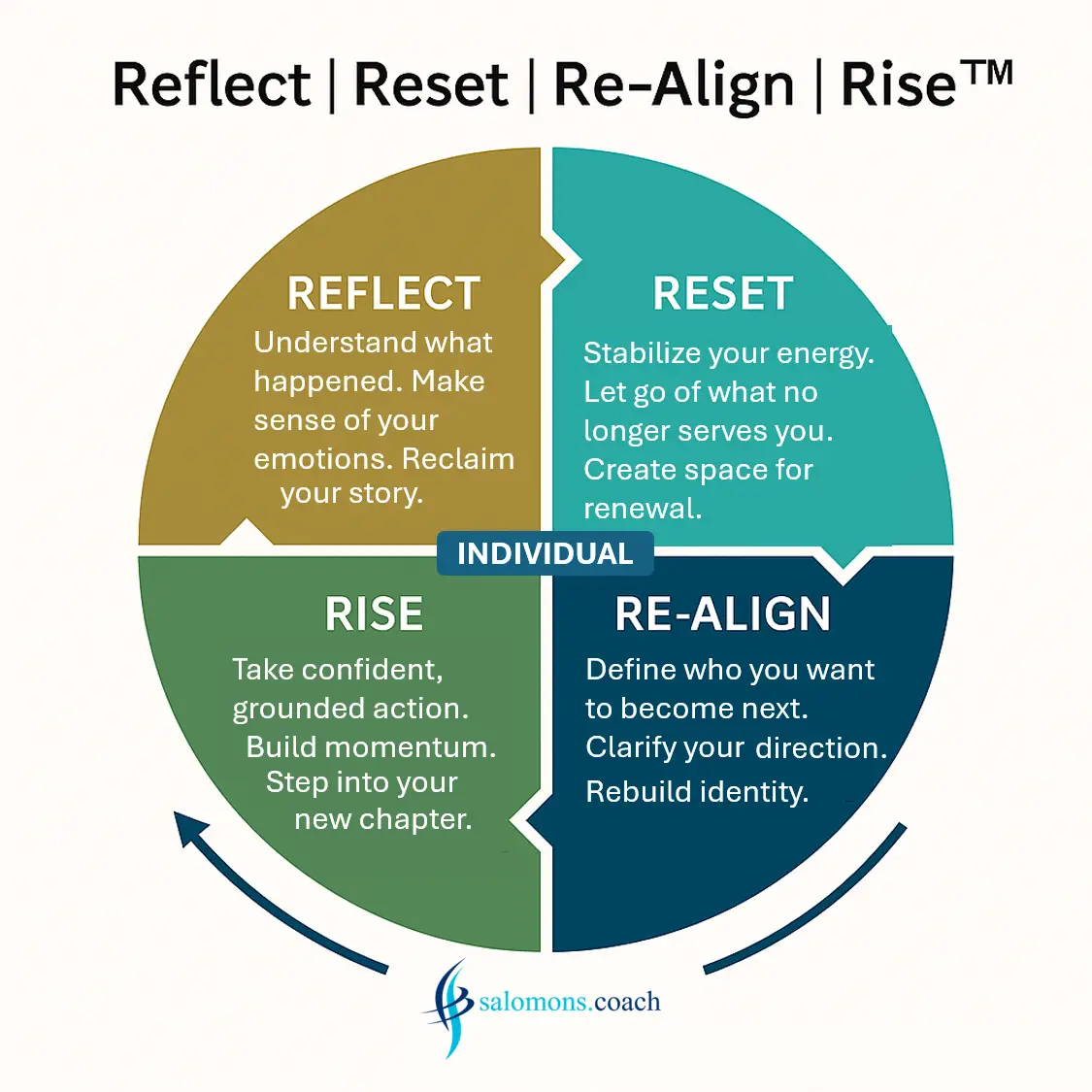When redundancy becomes a turning point: What leaders get wrong and how employees can rise stronger (context: The Netherlands)

Executive summary: redundancy as a leadership test and an opportunity for renewal

Redundancy in the Netherlands is highly structured through labor law and the Vaststellingsovereenkomst (VSO) process. Legally, the path is predictable. Psychologically, it is one of the most destabilizing moments in a professional career.
Across Dutch organizations, redundancy disrupts more than employment. It affects identity, confidence, and belonging. Research from Eurofound, OECD, INSEAD, and London Business School confirms that job loss in high-skilled economies triggers emotional and cognitive responses similar to acute stress events, regardless of performance or seniority.
The primary drivers of redundancy today are systemic, not personal: accelerated restructuring, digitalization, automation, international consolidation, and relentless cost pressures. As a result, the probability that Dutch professionals will encounter redundancy at least once in their career continues to rise, especially when you have past your mid-career point (Eurofound in 2025: “Older workers face a higher risk of long-term unemployment, with the rate 13.5 percentage points higher than for mid-career workers.”).
The VSO period, while legally clear, places individuals in a psychologically ambiguous “in-between state”: present but detached, accountable yet no longer belonging. This liminal phase increases cognitive overload, stress, and decision paralysis. Many professionals withdraw socially during this phase, amplifying shame and slowing recovery.
Leaders frequently mishandle redundancy communication by being either overly clinical or overly apologetic, both approaches undermine dignity, clarity, and trust. The impact extends beyond the departing employee to the colleagues who remain. Poorly handled redundancies weaken engagement, psychological safety, and performance for years. Well-handled redundancies strengthen organizational culture and trust.
Supporting research:
Research in the Netherlands shows that when organizations deploy structured HR support for employees facing dismissal, the risk of extended unemployment declines. (Borghouts-van de Pas et al., 2021)
According to the 2024 Outplacement & Career Mobility Trends Report, nearly half of HR leaders state they provide career coaching to departing employees, though only 1 in 10 employees report actually receiving it. The European outplacement market is shifting toward coaching-led, personalized career transition programs rather than ad-hoc CV workshops.” (Manage HR Magazine, 2024)
A structured coaching approach significantly improves outcomes. The 4R Model, Reflect, Reset, Re-Align, Rise, supports individuals in navigating emotional disruption, rebuilding identity, designing future direction, and re-entering the labor market with clarity and confidence. This structured transition support is increasingly used by Dutch organizations during the VSO period to protect both employee well-being and business continuity.
Redundancy is not a verdict on capability. With the right support, it becomes an inflection point, a moment to re-evaluate, re-align, and rise into a more purposeful and sustainable next chapter.
When redundancy becomes a turning point: What leaders get wrong and how employees can rise stronger (context: The Netherlands)
“Redundancy is not simply a restructuring outcome. It is a disruption of identity, belonging, and meaning.”
— Adapted from research by the European Agency for Safety and Health at Work (EU-OSHA)
Redundancy in the Netherlands carries a particular complexity. Dutch labour laws, strong employee protections, collective bargaining structures, and the use of the Vaststellingsovereenkomst (VSO) create a formal, highly regulated process. On paper, the system looks predictable and fair.
In practice, it is still profoundly destabilising.
Across Dutch industries, from manufacturing and transportation to technology, banking, and government, redundancy triggers a psychological response that is far deeper than most management teams anticipate. And as European labor markets undergo accelerated digitalization, demographic shifts, and new economic pressures, the probability of employees facing redundancy at least once in their career continues to rise.
According to OECD Employment Outlook data, workers over 45 in Europe are statistically more likely to face job loss during restructuring, and often take longer to re-enter the labor market, not because of capability gaps, but because of identity disruptions and confidence loss.
My coaching practice confirms what research already suggests:
Redundancy is not a performance outcome. It is a systemic response to volatility.
And individuals experience it as an emotional event long before they can process it as a rational one.
Why redundancy hits so hard in a Dutch and European context
The Dutch labour market is embedded in a broader European trend: organisations are restructuring faster than leadership structures can keep up.
Across Europe, Eurofound’s research on organisational change highlights the same drivers:
- Shorter strategic cycles driven by economic volatility
- Digitalisation and automation reshaping job families
- Cross-border consolidation pushing local teams to reorganise
- Cost pressures and efficiency mandates in multinational firms
- New flexible workforce models creating fluid organisational boundaries
The Netherlands mirrors this trend with characteristic Dutch pragmatism: direct communication, efficient processes, and a reliance on structured legal frameworks such as the VSO.
But emotionally, even a well-managed process hits hard.
Redundancy becomes a moment where professional identity, personal worth, and future direction suddenly collide.
The VSO period: Legally clear, psychologically ambiguous
A Dutch VSO follows a predictable sequence:
- The role is declared redundant
- VSO conditions are presented
- A 14-day reflection period begins
- Both parties sign
- Transition payment and separation terms are finalised
- The employee transitions to WW or begins new employment
Leaders often view this as closure.
Employees experience it as liminality, a transitional psychological space where identity is temporarily suspended:
- You are still present, but no longer belonging.
- Still delivering, but no longer part of the future.
- Still accountable, but already letting go.
This emotional ambiguity is consistent with findings from INSEAD’s research on transition psychology, which shows that “identity disruption” has more impact on professional stability than the job loss itself.
To counter this, many Dutch and European organizations now hire external coaches during the VSO period specifically to guide managers and executives through this transition. This is the work I am frequently engaged in: helping people stabilize, regain clarity, and design their next chapter with dignity. When done well, this support strengthens organizational trust, both for those leaving and for those who remain.
The emotional curve of redundancy: A predictable but misunderstood process
European research consistently shows the same emotional stages across cultures, though the Dutch response is shaped by the cultural preference for self-reliance and directness.
1. Shock — “This can’t be happening.”
Even predictable reorganizations trigger a physiological stress response. The body freezes, cognition narrows, and logical reasoning temporarily declines.
This aligns with findings from the Chartered Institute of Personnel and Development (CIPD), which shows that redundancy activates the same neurological pathways as other forms of acute loss.
2. Loss of identity — “Who am I without this role?”
Work provides belonging, mastery, routine, structure, status, and meaning.
In high-skilled economies like the Netherlands, identity is strongly tied to expertise. Losing a role often disrupts self-worth far more than expected.
3. Withdrawal or silence — “I’ll fix this privately first.”
Dutch professionals, more than many European peers, tend to withdraw during difficult moments.
Eurofound notes this self-reliance as a cultural factor in delayed help-seeking.
But silence fuels shame—and shame drains energy.
4. Stress, cognitive overload, emotional turbulence
People often misinterpret this as personal weakness. In reality, it is a temporary neurological shift where the amygdala dominates and the prefrontal cortex (decision-making) shuts down.
This is why external support during the VSO period is so crucial.
5. The turning point — Agency returns
This shift, from “Why is this happening?” to “What do I want next?”, marks the beginning of recovery.
It aligns with research from the London Business School on identity transition, showing that regaining agency is the single strongest predictor of successful reintegration into the labour market.
6. Integration — “This changed me.”
Many professionals report positive long-term outcomes: clearer values, stronger boundaries, healthier work-life choices, and renewed direction.
As one client summarised:
“I thought redundancy was an ending. It became the reset I didn’t know I needed.”
What leaders often get wrong, and why it matters more than they think
Redundancy conversations frequently fall into two unhelpful extremes:
1. Too clinical
Legally correct, emotionally blind.
“The OR has approved. HR will take it from here.”
2. Too apologetic
Well-intentioned but unclear, placing emotional burden on the employee.
“I hate telling you this… this is really hard for me…”
What employees and organizations actually need is:
- clarity
- composure
- dignity
- space for reaction
- follow-up
- visible care
- practical support
Leaders also often overlook the effect on stayers, the colleagues who remain.
Multiple European studies show that poorly handled redundancies erode:
- trust
- engagement
- psychological safety
- collaboration
- performance
Handled well, redundancies can strengthen the culture.
Handled poorly, their impact can be felt years later.
A Coaching Approach to Moving Forward: The 4R Model
Drawing on my experience guiding Dutch managers and professionals through VSO transitions, I use a four-stage model:

1. Reflect – Make sense of what happened. Understand the emotional, cognitive, and identity impact.
2. Reset – Stabilize energy, interrupt stress loops, and rebuild psychological space.
3. Re-Align – Define values, strengths, and direction for the next phase, not based on fear, but on aspiration.
4. Rise – Execute with clarity: networking, CV re-alignment, interview confidence, and a 90-day action plan.
This model aligns with research from INSEAD, London Business School, and the European Institute of Leadership & Management, all of which highlight structured reflection and identity work as critical in career transition success.
A Dutch case example from my coaching practice: “Anneke”
(Details anonymised)
Anneke, a senior manager in a transport organization, received a VSO as her entire management layer was removed. In 13 weeks of structured coaching, she:
- normalised her emotional response
- regained confidence
- separated identity from circumstance
- used the VSO period strategically
- built a future-fit narrative
- reactivated her network
- secured multiple offers
She ultimately accepted a role with healthier culture, greater autonomy, and renewed purpose.
Her reflection:
“Redundancy was not the end. It was an inflection point.”
A final message for anyone facing redundancy in the Netherlands
Redundancy is not a verdict.
It is a transition and transitions, when supported, become turning points.
With the right guidance, this period becomes an opportunity to: Reflect > Reset > Re-Align > Rise.
In my work, I help organizations support employees with dignity during the VSO period and help individuals rediscover clarity, confidence, and momentum.
You are not alone.
You are not behind.
You are evolving.
If you want to have a free and open conversation to see how my support could be helpful, simply contact me here.
Evidence Sources & Key Insights
- “Unemployment prevention: The role of Human Resource Practices” by I. Borghouts-van de Pas et al. (2021)
- This Dutch-study shows that proactive HR practices — including guidance and counselling for employees at risk of unemployment (i.e., following dismissal) — reduce the risk of longer-term unemployment. instituutgak.nl
- Key takeaway: structured support for redundant employees is correlated with improved labour-market reintegration and less negative consequence for both the individual and the organisation.
- “Outplacement and Career Mobility 2024 Trends Report” (CityHR)
- The 2024 European report notes that “career coaching, mentoring, and outplacement services” are identified by HR leaders as a strategic tool during redundancies:
- 45% of HR leaders say they provide career coaching to redundant employees, but only 10% of employees report receiving it. City HR
- Key takeaway: organisations recognise structured transition support as a protective factor (for employee well-being, employer brand, business continuity), even if delivery gaps exist.
- The 2024 European report notes that “career coaching, mentoring, and outplacement services” are identified by HR leaders as a strategic tool during redundancies:
- “The changing landscape of outplacement in Europe” (Manage HR Magazine, Jan 2024)
- Highlights that:
- The European outplacement market is shifting toward personalised coaching and career-trajectory support, not just CV help. Manage HR Magazine
- Key takeaway: the outplacement/coaching sector is evolving to give deeper, strategic value — aligning well with your “Reflect-Reset-Re-Align-Rise” structured approach.
- Highlights that:
- Outplacement services website evidence (Netherlands / European providers)
- For example: A Dutch outplacement firm claims 95% success in placing former employees through a structured coaching trajectory. Together Abroad
- Key takeaway: In the Dutch context, structured coaching/outplacement is already being used and delivers outcomes; this supports your point that corporates hire support during the VSO phase.




